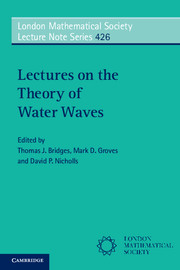Book contents
- Frontmatter
- Contents
- Contributors
- Preface
- 1 High-Order Perturbation of Surfaces Short Course: Boundary Value Problems
- 2 High-Order Perturbation of Surfaces Short Course: Traveling Water Waves
- 3 High-Order Perturbation of Surfaces Short Course: Analyticity Theory
- 4 High-Order Perturbation of Surfaces Short Course: Stability of Traveling Water Waves
- 5 A Novel Non-Local Formulation of Water Waves
- 6 The Dimension-Breaking Route to Three-Dimensional Solitary Gravity-Capillary Water Waves
- 7 Validity and Non-Validity of the Nonlinear Schrödinger Equation as a Model for Water Waves
- 8 Vortex Sheet Formulations and Initial Value Problems: Analysis and Computing
- 9 Wellposedness and Singularities of the WaterWave Equations
- 10 Conformal Mapping and Complex Topographies
- 11 Variational Water Wave Modelling: from Continuum to Experiment
- 12 Symmetry, Modulation, and Nonlinear Waves
- References
1 - High-Order Perturbation of Surfaces Short Course: Boundary Value Problems
Published online by Cambridge University Press: 05 February 2016
- Frontmatter
- Contents
- Contributors
- Preface
- 1 High-Order Perturbation of Surfaces Short Course: Boundary Value Problems
- 2 High-Order Perturbation of Surfaces Short Course: Traveling Water Waves
- 3 High-Order Perturbation of Surfaces Short Course: Analyticity Theory
- 4 High-Order Perturbation of Surfaces Short Course: Stability of Traveling Water Waves
- 5 A Novel Non-Local Formulation of Water Waves
- 6 The Dimension-Breaking Route to Three-Dimensional Solitary Gravity-Capillary Water Waves
- 7 Validity and Non-Validity of the Nonlinear Schrödinger Equation as a Model for Water Waves
- 8 Vortex Sheet Formulations and Initial Value Problems: Analysis and Computing
- 9 Wellposedness and Singularities of the WaterWave Equations
- 10 Conformal Mapping and Complex Topographies
- 11 Variational Water Wave Modelling: from Continuum to Experiment
- 12 Symmetry, Modulation, and Nonlinear Waves
- References
Summary
Abstract
In this lecture we introduce two classical High-Order Perturbation of Surfaces (HOPS) computational schemes in the simplified context of elliptic boundary value problems inspired by models in water waves. For the problem of computing Dirichlet–Neumann Operators (DNOs) for Laplace's equation, we outline Bruno & Reitich's method of Field Expansions (FE) and then describe Milder and Craig & Sulem's method of Operator Expansions (OE). We further show how these algorithms can be extended to three dimensions and finite depth, and describe how Padé approximation can be used as a method of numerical analytic continuation to realize enhanced performance and applicability through a series of numerical experiments.
Introduction
Calculus in general, and Partial Differential Equations (PDEs) in particular have long been recognized as the most powerful and successful mathematical modeling tool for engineering and science, and the study of surface water waves is no exception. With the advent of the modern computer in the 1950s, the possibility of numerical simulation of PDEs at last became a practical reality. The last 50–60 years has seen an explosion in the development and implementation of algorithms for this purpose, which are rapid, robust, and highly accurate. Among the myriad choices are:
Finite Difference methods (e.g., [1–4]),
Finite Element methods (Continuous and Discontinuous) (e.g., [5–8]),
High-Order Spectral (Element) methods (e.g., [9–14]),
Boundary Integral/Element methods (e.g., [15, 16]).
The class of High-Order Perturbation of Surfaces (HOPS) methods we describe here are a High-Order Spectral method, which is particularly well suited for PDEs posed on piecewise homogeneous domains. Such “layered media” problems abound in the sciences, e.g., in
• free-surface fluid mechanics (e.g., the water wave problem),
• acoustic waves in piecewise constant density media,
• electromagnetic waves interacting with grating structures,
• elastic waves in sediment layers.
For such problems these HOPS methods can be
• highly accurate (error decaying exponentially as the number of degrees of freedom increases),
• rapid (an order of magnitude fewer unknowns as compared with volumetric formulations),
• robust (delivering accurate results for rather rough/large interface shapes).
However, these HOPS schemes are not competitive for problems with inhomogeneous domains and/or “extreme” geometries.
- Type
- Chapter
- Information
- Lectures on the Theory of Water Waves , pp. 1 - 18Publisher: Cambridge University PressPrint publication year: 2016
References
- 1
- Cited by



